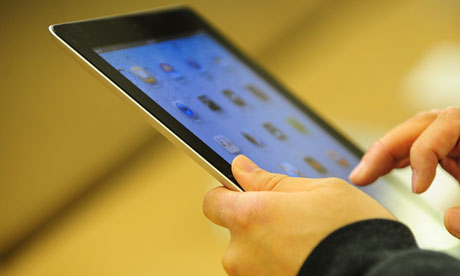
What is it? Are you serious? Unless you've been living in 2009 for the last two years, then you're already sick to the back teeth of reading about whether Apple's tablet has revolutionised portable computing or whether it's an emperor/no clothes algorithm. What you probably haven't read so much about, though, is what the iPad represents to the music-making community.
Who uses it? Already, virtually everyone reading this will either have an iPad or know someone with one. Gadget fiends and those loyal to the Apple brand snapped the pad up unquestioningly. Translate that to the music world (a natural haven for geeks and gearheads) and you'll find iPads littering tour buses, hotel rooms, recording studios and wannabe rock stars' bedrooms everywhere. XL Recordings boss Richard Russell has been raving about the device on his Twitter feed. And its portability, multi-functionality and intrinsic must-keep-touchingness meant that Damon Albarn not only managed to write an entire new Gorillaz album on his iPad while on tour, but the quality of the audio was such that he could release it online pretty much as was.
How does it work? It's the infinite, bewildering dazzle of the apps, goddammit! In a machine small enough to fit into your satchel and use on the bus, you can store and tweak at the touch of a finger an absolutely massive amount of synths, fancy digital instruments, emulators, sequencers and other sound-editing gadgets. You can also record real instruments and vocals directly into the iPad, editing audio and crafting your sketches into songs with the most user-friendly music-making software there currently is on any platform.
Where does it come from? Apple's first tablet computer actually launched in 1993, but the series had run out of steam by 1998. Their attempt to revive the tablet format in the 2000s paused when Apple realised they could port the exact same operating system and interface to an even smaller, handheld device – what became the iPhone.
Why is it classic? Here are a few reasons. Looptastic is an app that allows you to create, sequence and manipulate up to 32 loops at once, adding real-time effects with an X/Y controller and the ability to import sound-clips over wi-fi. Korg have really taken the iPad to heart – the app modelling their much-loved Electribe groovebox is virtually identical to its hardware equivalent, but for a tiny fraction of their price (£5.99 for the app version, £449 for the proper box), and the Korg iMS-20 has to be the most popular software synth there is right now. Also, out this month is a whole new version of GarageBand specifically for the iPad 2, which, although unlikely to compete with Ableton Live or Logic in the desktop rig of a pro musician, looks set to be a brilliant tool for noting down ideas on the fly and painlessly arranging them into complete multitrack compositions. Although it's easy to balk at the unashamedly flashy nature of Apple devices, even factoring in the cost of the hardware, an iPad full of music-making apps represents a formidable and – compared with buying in hardware – relatively inexpensive tool for writing and recording music.
What is the best ever iPad song? Let's go with Phoner to Arizona, from Gorillaz's iPad album, The Fall.
Five facts and things
* As well as music-making apps, there's loads of DJing software for the iPad. Sonorasaurus Rex, Flare Scratch, Mixr and Baby Decks are apps you should check out if you're a DJ thinking of making the transition from laptops to iPad. We're not going to convert vinyl DJs here though (and why should we?) so let's leave that one for now.
* Was Damon Albarn's The Fall the first-ever album to be produced entirely on iPad? Actually, no. An American DJ named Rana June Sobhany caused a ripple with her Destroy the Silence effort, recorded using two iPads running iElectribe and Looptastic, crossfaded through a conventional DJ mixer.
* OK, so The Fall was actually mixed and mastered at Abbey Road studios, but apart from that it was made on an iPad.
* Although futuristic interfaces such as RjDj's Voyager app fulfil Apple's brief to be constantly on the bleeding-edge of technology, music notation software such as Symphony Pro is also breaking new ground. Notation software exists for desktop computers too, but the iPad is compact enough to sit on a music stand or piano while you're playing or composing.
* The biggest obstacle to the iPad becoming a serious piece of musical hardware? Its inability to multitask. "It's hard enough to mix beats together when dealing with laptops," says Rana Sobhany. "Now imagine that with two independent computing platforms with no ability to sync. The lack of multitasking in the OS makes it really hard to transition quickly between apps."

